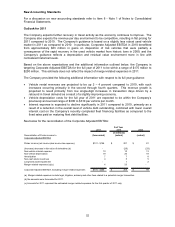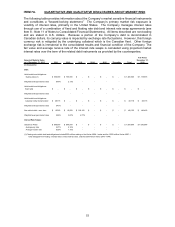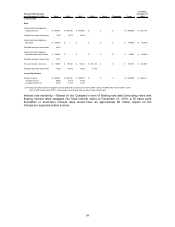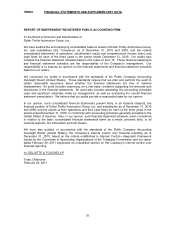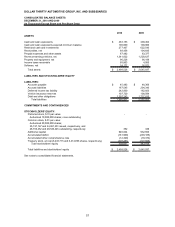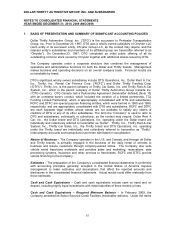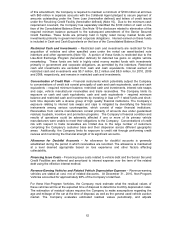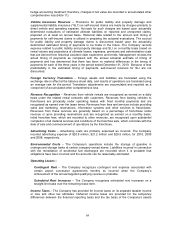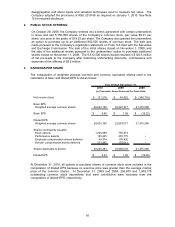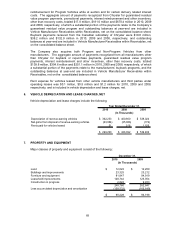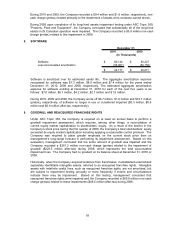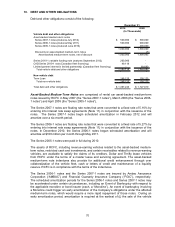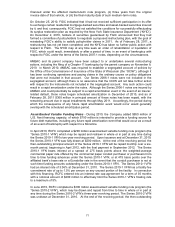Thrifty Car Rental 2010 Annual Report Download - page 63
Download and view the complete annual report
Please find page 63 of the 2010 Thrifty Car Rental annual report below. You can navigate through the pages in the report by either clicking on the pages listed below, or by using the keyword search tool below to find specific information within the annual report.of this amendment, the Company is required to maintain a minimum of $100 million at all times
with $60 million in separate accounts with the Collateral Agent pledged to secure payment of
amounts outstanding under the Term Loan (hereinafter defined) and letters of credit issued
under the Revolving Credit Facility (hereinafter defined) (Note 10). Due to the minimum cash
requirement covenant, the Company has separately identified the $100 million of cash on the
face of the Consolidated Balance Sheet. See Note 19 for disclosure related to elimination of the
required minimum balance pursuant to the subsequent amendment of the Senior Secured
Credit Facilities. These funds are primarily held in highly rated money market funds with
investments primarily in government and corporate obligations. Interest earned on these funds
is included in Cash and Cash Equivalents on the face of the Consolidated Balance Sheet.
Restricted Cash and Investments – Restricted cash and investments are restricted for the
acquisition of vehicles and other specified uses under the rental car asset-backed note
indenture and other agreements (Note 10). A portion of these funds is restricted due to the
Like-Kind Exchange Program (hereinafter defined) for deferred tax gains on eligible vehicle
remarketing. These funds are held in highly rated money market funds with investments
primarily in government and corporate obligations, as permitted by the indenture. Restricted
cash and investments are excluded from cash and cash equivalents. Interest earned on
restricted cash and investments was $0.7 million, $3.2 million and $8.9 million, for 2010, 2009
and 2008, respectively, and remains in restricted cash and investments.
Concentration of Credit Risk – Financial instruments which potentially subject the Company
to concentrations of credit risk consist principally of cash and cash equivalents, cash and cash
equivalents – required minimum balance, restricted cash and investments, interest rate swaps
and caps, vehicle manufacturer receivables and trade receivables. The Company limits its
exposure on cash and cash equivalents, cash and cash equivalents – required minimum
balance and restricted cash and investments by investing in Aaa or P-1 rated funds and short-
term time deposits with a diverse group of high quality financial institutions. The Company’s
exposure relating to interest rate swaps and caps is mitigated by diversifying the financial
instruments among various counterparties, which consist of major financial institutions.
Receivables from vehicle manufacturers consist primarily of amounts due under guaranteed
residual, buyback, incentive and promotion programs. The Company’s financial condition and
results of operations could be adversely affected if one or more of its primary vehicle
manufacturers were unable to meet their obligations to the Company. Concentrations of credit
risk with respect to trade receivables are limited due to the large number of customers
comprising the Company’s customer base and their dispersion across different geographic
areas. Additionally, the Company limits its exposure to credit risk through performing credit
reviews and monitoring the financial strength of its significant accounts.
Allowance for Doubtful Accounts – An allowance for doubtful accounts is generally
established during the period in which receivables are recorded. The allowance is maintained
at a level deemed appropriate based on loss experience and other factors affecting
collectability.
Financing Issue Costs – Financing issue costs related to vehicle debt and the Senior Secured
Credit Facilities are deferred and amortized to interest expense over the term of the related
debt using the effective interest method.
Revenue-Earning Vehicles and Related Vehicle Depreciation Expense – Revenue-earning
vehicles are stated at cost, net of related discounts. At December 31, 2010, Non-Program
Vehicles accounted for approximately 98% of the Company’s total fleet.
For these Non-Program Vehicles, the Company must estimate what the residual values of
these vehicles will be at the expected time of disposal to determine monthly depreciation rates.
The estimation of residual values requires the Company to make assumptions regarding the
age and mileage of the car at the time of disposal, as well as the general used vehicle auction
market. The Company evaluates estimated residual values periodically, and adjusts
62


